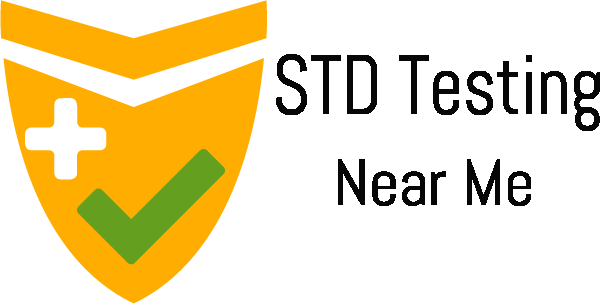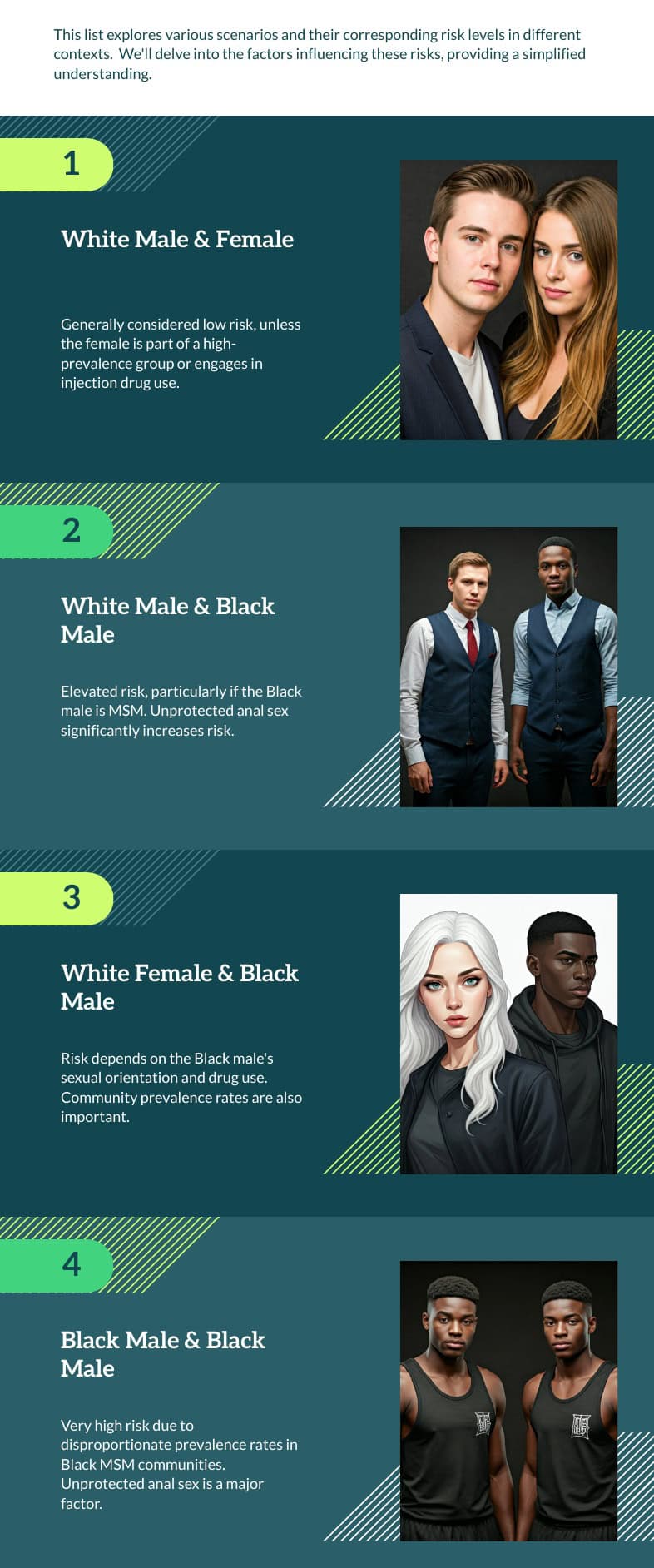HIV remains a critical public health issue in the United States, where diverse communities are affected in different ways. While much attention has focused on HIV transmission among men who have sex with men (MSM), it is equally important to understand the risk associated with unprotected heterosexual and bisexual sexual behaviors. This blog delves into the risk levels for acquiring HIV for men and women through these routes, with a particular focus on how these risks vary by race. Data and reports from the Centers for Disease Control and Prevention (CDC), the World Health Organization (WHO), and the American HIV Institute provide the basis for the statistics and risk percentages discussed here.
Overview of HIV Transmission Through Sexual Contact
HIV (human immunodeficiency virus) is transmitted through the exchange of certain body fluids, most notably blood, semen, vaginal fluids, and rectal fluids. In sexual contexts, unprotected intercourse—meaning sex without the use of a condom or other barrier method—can facilitate the virus’s transmission if one partner is HIV-positive and the other is not. Although antiretroviral therapy (ART) and the concept of “undetectable = untransmittable” have changed the landscape of HIV prevention, many individuals continue to engage in unprotected sex, thereby increasing their risk of infection.
For both heterosexual and bisexual individuals, the risk associated with unprotected sex is determined by several factors, including:
-
The type of sexual act (vaginal, anal, or oral sex)
-
The presence of other sexually transmitted infections (STIs)
-
The viral load of an HIV-positive partner
-
The frequency of exposure
Per-Act HIV Transmission Risk
Scientific studies have estimated the per-act risk of HIV transmission during unprotected sex. Although these percentages are averages and can vary from study to study, they provide a useful guideline for understanding relative risk. Consider the table below:
| Sexual Act Type | Estimated Transmission Risk per Act (%) |
|---|---|
| Vaginal (male-to-female) | 0.08 – 0.10 |
| Vaginal (female-to-male) | 0.04 – 0.07 |
| Receptive Anal (male or bisexual)* | 1.38 – 1.70 |
| Insertive Anal (male or bisexual)* | 0.11 – 0.62 |
| Oral Sex (receptive or insertive) | <0.01 (nearly negligible) |
*Note: Bisexual individuals who engage in anal intercourse face similar risks to MSM, where receptive anal sex carries the highest risk of transmission.
This table illustrates that, on a per-act basis, vaginal intercourse carries a much lower risk than anal intercourse. Nonetheless, because vaginal sex is far more common, it contributes significantly to the total number of new infections—especially among heterosexual populations.
Heterosexual Transmission of HIV
Heterosexual transmission remains one of the primary modes of HIV spread in the United States. According to recent CDC data, individuals who acquire HIV through heterosexual contact represent a significant portion of new infections. In 2022, heterosexual contact was responsible for about 22% of the estimated 31,800 new HIV infections in the country. Breaking that down further:
-
Men reporting heterosexual contact accounted for approximately 7% (about 2,100 cases) of new infections.
-
Women reporting heterosexual contact contributed roughly 15% (around 4,900 cases) of the new infections.
These figures underline that while both men and women are at risk, women tend to acquire HIV through heterosexual contact at a higher rate. Biological factors, such as the larger surface area of the vaginal mucosa and a higher likelihood of micro-abrasions during intercourse, may partly explain this difference.
Risk Factors Specific to Heterosexual Transmission
Several factors can elevate the risk of HIV transmission during heterosexual sex:
-
Co-infection with other STIs: The presence of an STI or genital ulcer can increase HIV transmission risk by up to five times, as the inflammation or disruption of mucosal barriers facilitates the entry of the virus.
-
High viral load in the HIV-positive partner: Individuals who are not on effective antiretroviral therapy and have high viral loads are significantly more infectious.
-
Frequency of exposure: The cumulative risk increases with the number of exposures or sexual acts.
Behavioral factors, including inconsistent condom use, substance abuse, and lack of regular HIV testing, further exacerbate these risks. Addressing these factors through education, improved access to healthcare, and targeted prevention campaigns is essential to reducing new infections.
HIV Risk Among Bisexual Individuals
Bisexual individuals—those who engage in sexual relationships with both men and women—face unique challenges when it comes to HIV risk. Their behaviors may include both heterosexual and homosexual activities, and the risk level varies accordingly. For instance:
-
Unprotected vaginal sex: The risk is similar to that for heterosexual individuals (approximately 0.04–0.10% per act, depending on direction).
-
Unprotected anal sex: When bisexual men or women engage in anal intercourse, the risk increases substantially, particularly for the receptive partner, who may face a transmission risk of around 1.38–1.70% per act.
Because bisexual individuals may not be as visible in HIV prevention campaigns—which often focus on MSM or heterosexual populations exclusively—they can sometimes be overlooked in both research and public health initiatives. This underrepresentation can lead to a gap in tailored prevention strategies and lower rates of testing or access to pre-exposure prophylaxis (PrEP).
Risk Contexts for Bisexual Transmission
For bisexual men, risk is influenced by both male-to-male and male-to-female sexual contacts. Studies have shown that:
-
The high prevalence of HIV among MSM (especially among Black and Hispanic communities) means that engaging in unprotected anal sex with a male partner can be particularly risky.
-
In contrast, unprotected vaginal intercourse, although lower risk per act, is more common and therefore remains an important contributor to overall risk.
Similarly, bisexual women may have partners of both sexes. Even though the risk of female-to-female transmission is negligible, many bisexual women have sexual relationships with men and might also have histories of injection drug use, which further increases their risk.
Understanding the risk for bisexual individuals requires acknowledging that their behaviors and networks might bridge different communities, potentially serving as a conduit for HIV transmission between higher-prevalence groups (such as MSM) and lower-prevalence groups (such as heterosexual populations).
Racial Disparities in HIV Infection
One of the most striking aspects of the HIV epidemic in the United States is its disproportionate impact on racial and ethnic minorities. CDC reports have repeatedly shown that Black/African American and Hispanic/Latino populations experience higher rates of new HIV infections than their White counterparts, despite representing a smaller percentage of the overall population.
Estimated Distribution of New HIV Infections by Race/Ethnicity
The following table summarizes how new HIV infections are distributed among different racial/ethnic groups. It highlights the disproportionate impact on minority populations:
| Race/Ethnicity | Approx. % of US Population | Approx. % of New HIV Infections | Relative Risk Compared to Whites |
|---|---|---|---|
| Black/African American | ~12% | ~37% | ~3× higher risk |
| Hispanic/Latino | ~18% | ~33% | ~1.5× higher risk |
| White | ~61% | ~24% | Baseline |
| Other (Asian, American Indian/Alaska Native, Native Hawaiian/Other Pacific Islander, Multiracial) | ~9% (combined) | ~6% (combined) | Lower relative risk |
*Note: These percentages are approximate and based on recent CDC data and related reports. They illustrate that Black/African American and Hispanic/Latino populations bear a disproportionate burden of new HIV infections compared to Whites.
Impact on Heterosexual and Bisexual Transmission
When examining heterosexual transmission, the CDC data indicate that:
-
Black women experience a significantly higher risk of acquiring HIV through unprotected heterosexual contact compared to White and Hispanic women.
-
Heterosexual Black men also face higher risks, although the overall numbers are lower than among women.
For bisexual individuals, the racial disparities seen in MSM populations also apply. Bisexual men of color, for instance, are at higher risk during male-to-male encounters due to the elevated prevalence in their communities. Similarly, bisexual women from minority groups may encounter higher risks if they have partners within higher-prevalence networks.
A comprehensive understanding of these risks must take into account the intersection of race, sexual behavior, and access to prevention resources. Public health initiatives must therefore be culturally sensitive and targeted to address the unique needs of these communities.
The Role of Non-Protected Sex in HIV Transmission
At the core of HIV transmission is the absence of protective measures during sexual activity. Non-protected or unprotected sex—sex without condoms or without using biomedical prevention methods like PrEP—increases the likelihood of HIV transmission with every encounter. Whether the act is heterosexual or bisexual, consistent use of protection dramatically reduces the risk.
Why Protection Matters
Using condoms correctly and consistently is one of the most effective ways to prevent HIV transmission. Condoms serve as a barrier to the exchange of bodily fluids and have been shown to reduce the risk of HIV by approximately 80% or more when used correctly. Moreover, biomedical interventions such as PrEP have added an extra layer of protection for those at high risk.
Without these measures, even low per-act transmission risks can accumulate over time. For example, although the per-act risk of HIV transmission during vaginal intercourse may be around 0.08%, repeated exposures—especially when combined with factors such as other STIs or high viral loads—can lead to a significant cumulative risk.
Table: Comparative Risk of HIV Transmission Per Sexual Act
| Sexual Act | Estimated Risk per Act (%) | Notes |
|---|---|---|
| Vaginal intercourse | 0.08 – 0.10 (male-to-female) | Higher risk if the HIV-positive partner has a high viral load or an STI. |
| Vaginal intercourse | 0.04 – 0.07 (female-to-male) | Lower than male-to-female due to biological differences. |
| Receptive anal intercourse | 1.38 – 1.70 | Highest risk; mucosal tearing can occur. |
| Insertive anal intercourse | 0.11 – 0.62 | Risk varies based on circumcision status and other factors. |
| Oral sex | <0.01 | Considered very low risk, though not zero. |
*Note: For bisexual individuals, the risk will depend on which acts they engage in. If they engage in both vaginal and anal sex, the overall risk is a function of the frequency and type of each encounter.
This table emphasizes that although some sexual activities carry a low risk per act, the overall risk can increase significantly with repeated exposure and in the absence of preventive measures.
Prevention and Reducing Risk
Given the elevated risks associated with non-protected sex, a multipronged approach to prevention is essential. Key strategies include:
Consistent Condom Use: Condoms are a simple yet powerful tool in preventing HIV. Their consistent and correct use during both vaginal and anal intercourse can reduce the risk of transmission by as much as 80% or more.
Pre-Exposure Prophylaxis (PrEP): PrEP is a daily medication that, when taken consistently, can reduce the risk of acquiring HIV by up to 99% in individuals at high risk. Despite its effectiveness, uptake among bisexual populations and racial/ethnic minorities remains lower than optimal.
Regular HIV Testing: Early diagnosis is critical. Regular testing ensures that those who are HIV-positive can begin antiretroviral therapy (ART) early, reducing their viral load and lowering the risk of transmission.
Treatment as Prevention (TasP): For people living with HIV, achieving and maintaining an undetectable viral load through ART means they are effectively not transmitting the virus. This concept—often summarized as “undetectable = untransmittable (U=U)”—is a cornerstone of modern HIV prevention.
Sexual Health Education: Culturally appropriate education that addresses both heterosexual and bisexual behaviors is key to reducing stigma and increasing the uptake of preventive measures. Such education must also be tailored to address the unique challenges faced by racial and ethnic minorities.
Addressing Structural Barriers: Many communities at highest risk face socioeconomic challenges, including poverty, limited access to healthcare, and discrimination. Addressing these systemic issues is critical for reducing overall HIV risk.
Concluding Thoughts
The risk of acquiring HIV through non-protected heterosexual and bisexual sex varies by sexual act, frequency of exposure, and the presence of co-factors like STIs or high viral load in the HIV-positive partner. Although per-act transmission risks for vaginal intercourse are lower compared to anal intercourse, the cumulative risk remains significant, especially when prevention measures are not used consistently.
Racial disparities further complicate the epidemic in the United States. Black/African American and Hispanic/Latino populations are disproportionately affected, a reality that is mirrored in both heterosexual and bisexual transmission dynamics. For bisexual individuals, whose behaviors may span both heterosexual and same-sex encounters, targeted and culturally competent prevention efforts are essential.
Prevention strategies—ranging from consistent condom use and biomedical interventions such as PrEP, to regular HIV testing and improved sexual health education—offer a path to reducing new HIV infections. However, these measures must be accessible and acceptable across all communities. Addressing structural barriers and social determinants of health is equally important to ensure that everyone, regardless of race or sexual orientation, has the resources and support needed to protect themselves against HIV.
In conclusion, understanding and mitigating HIV risk requires a comprehensive approach that accounts for behavioral, biological, and socioeconomic factors. Through consistent prevention practices, early diagnosis, and culturally tailored public health interventions, it is possible to reduce the burden of HIV in the United States and work toward a future where new infections are dramatically curtailed.



